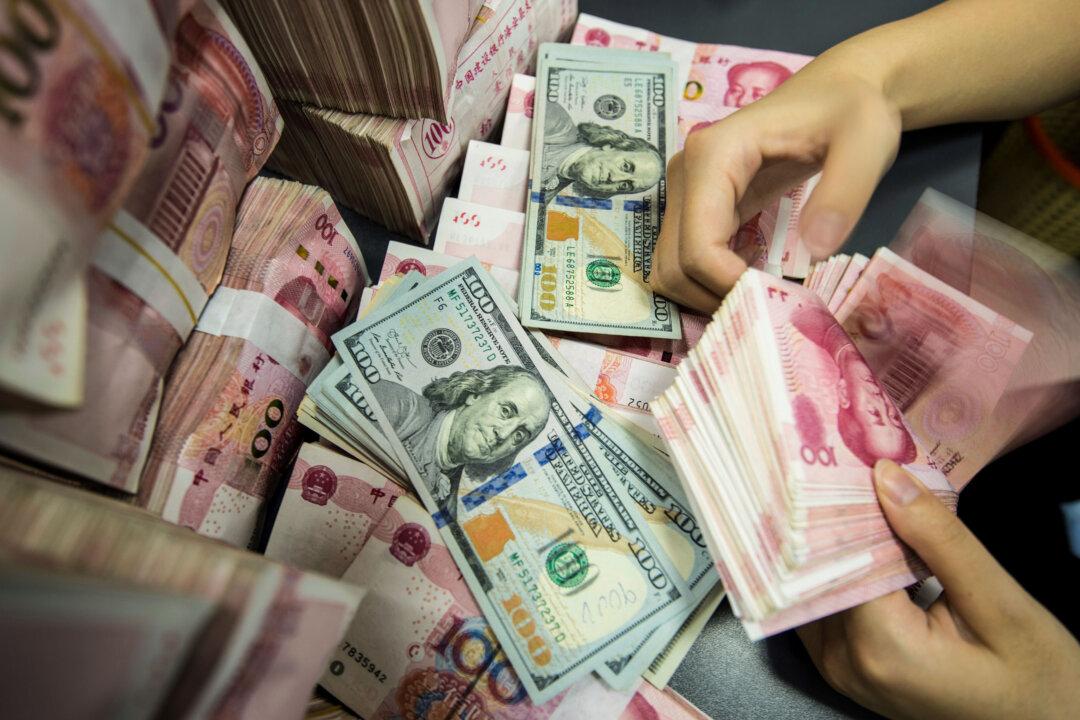China lends nearly $1 trillion to high-income countries, as much as its Belt and Road Initiative in the global South.

A Chinese bank employee counts 100-yuan notes and U.S. dollar bills at a bank counter in Nantong in eastern Jiangsu Province, China, on Aug. 28, 2019. AFP via Getty Images
Beijing is known for lending to low-income countries through its $1 trillion geopolitical program, known as the Belt and Road Initiative, but a new study shows that China’s official financing totaled more than $2 trillion worldwide from 2000 to 2023, with the United States ranking first among recipients, with more than $200 billion from nearly 2,500 projects.
The report, released on Nov. 18 by AidData, a research lab at the College of William and Mary in Virginia, offers a rare view into Chinese lending in developed countries.
The overall size of China’s cross-border lending was “two-to-four times larger” than previously understood, according to Brad Parks, AidData’s executive director. China’s lending to 72 high-income countries—nearly $1 trillion—is on a scale comparable to the lending of the Belt and Road Initiative.
Over the years, Beijing’s focus has shifted away from building bridges and railways. According to the study, Chinese overseas lending in advanced manufacturing rose from 46 percent in 2015 to 88 percent in 2023, coinciding with China’s “Made in China 2025” industrial policy announced 10 years ago.
The same priority is reflected in Chinese loans to entities in the United States; more than 40 percent of the total lending portfolio is in mining, biotechnology, and manufacturing, such as semiconductors.
Many U.S. private companies borrowed billions of dollars from Chinese state-owned banks. Some familiar names on that list are AT&T, Disney, BlackRock, MasterCard, American Airlines, United Airlines, Amazon, Oracle, and Ford.
The AidData study revealed that Chinese official funds bankroll critical projects such as liquefied natural gas construction in Texas and Louisiana, data centers in Northern Virginia, water utilities in California, and multi-state oil and natural gas pipelines in the United States.
“Much of the lending to wealthy countries is focused on critical infrastructure, critical minerals, and the acquisition of high-tech assets, like semiconductor companies,” Parks said.
Chinese lending data have also become more opaque, according to Katherine Walsh, coauthor of the report. She said AidData’s ability to obtain unredacted loan contracts of official Chinese creditors “sharply declined between 2022 and 2023.”
AidData’s research team said that to limit oversight, Beijing routed more funds through shell companies, made nondisclosure terms and conditions in contracts more stringent, and did more deals through non-Chinese front entities.
The team tapped into more than 246,000 sources, including public filings from stock exchanges and financial regulatory agencies and documents from international organizations such as the World Bank and the International Monetary Fund. The work took dozens of researchers three months to complete. Most of the data points are backed by at least one official source.
On the same day of the release of the AidData study, the bipartisan U.S.–China Economic and Security Review Commission published its annual report to Congress.
“Chinese overseas investment has been a strategic and blunt tool for advancing domestic industrial capabilities and helping close China’s gap with the technology frontier,” the report reads.
Terri Wu is a Washington-based freelance reporter for The Epoch Times covering education and China-related issues. Send tips to terri.wu@epochtimes.com.
